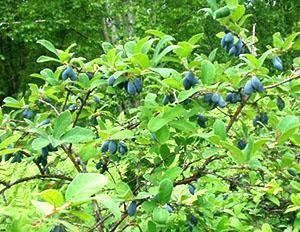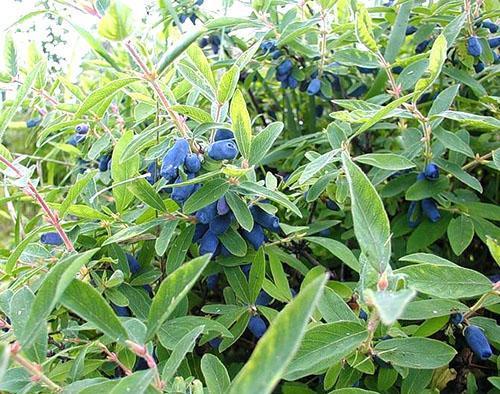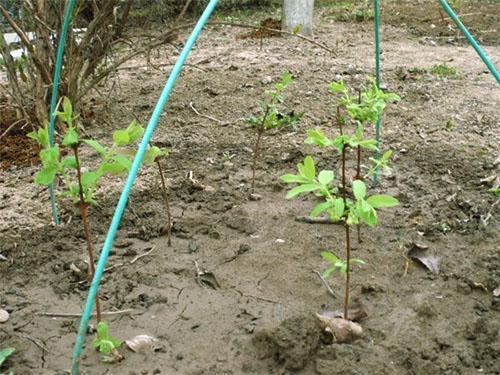Planting edible honeysuckle in the country and caring for plants
 Among the many priceless fruits and berries grown in the gardens, a special place is occupied by cultivars of edible honeysuckle. Its bushes delight with the annual harvest of the first summer berries. The shrub is not afraid of frost up to 50 degrees, and the flowers are preserved even with return frosts up to 8 0... It is important to ensure the development of the plant in early spring with moisture, and the harvest will be.
Among the many priceless fruits and berries grown in the gardens, a special place is occupied by cultivars of edible honeysuckle. Its bushes delight with the annual harvest of the first summer berries. The shrub is not afraid of frost up to 50 degrees, and the flowers are preserved even with return frosts up to 8 0... It is important to ensure the development of the plant in early spring with moisture, and the harvest will be.
Read the article in the topic: Honeysuckle - useful properties and contraindications.
Why honeysuckle is valuable

Berries of all varieties of edible honeysuckle are a healthy vitamin product.
How to grow honeysuckle in the garden
 The shrub likes a well-lit place without close standing groundwater and with light soil. This is a cross-pollinated plant, therefore several different varieties of plants should be planted. Then the ovary of berries will be much larger. Top dressing organic fertilizers will add productivity. Honeysuckle loves ash toppings, but does not like chemistry. Only light feeding with urea in spring, even before bud break, is accepted by the plant favorably. Therefore, growing edible honeysuckle is a pleasant experience, with consistently good results.
The shrub likes a well-lit place without close standing groundwater and with light soil. This is a cross-pollinated plant, therefore several different varieties of plants should be planted. Then the ovary of berries will be much larger. Top dressing organic fertilizers will add productivity. Honeysuckle loves ash toppings, but does not like chemistry. Only light feeding with urea in spring, even before bud break, is accepted by the plant favorably. Therefore, growing edible honeysuckle is a pleasant experience, with consistently good results.
Planting and caring for edible honeysuckle
 The biological cycle of the bush begins with early awakening. But the cessation of growth and lignification occurs in August. Question, when to transplant edible honeysuckle is decided based on the circumstances. So, for a good survival rate of a bush with bare roots, only an autumn planting is suitable. In the spring, you can plant a seedling obtained with a container growing method.
The biological cycle of the bush begins with early awakening. But the cessation of growth and lignification occurs in August. Question, when to transplant edible honeysuckle is decided based on the circumstances. So, for a good survival rate of a bush with bare roots, only an autumn planting is suitable. In the spring, you can plant a seedling obtained with a container growing method.
Plant propagation is carried out in several ways:
- seeds;
- cuttings;
- layering;
- dividing the bush.
The seed method is more often used in nurseries. In the process of growing, the bushes dive at a distance of 20 cm, grow and sell them at the age of three.
The more common breeding method is by rooting the cuttings. Growing edible honeysuckle from cuttings is a quick way to harvest. To get rooting, you should bend the shoot from the mother bush and pin it to the ground. In the place of contact with the soil, a trench is created or a mound of earth is poured on top. Roots will develop there. A new plant with well-developed roots is separated from the mother bush only the next year.
Rejuvenating care and planting of honeysuckle edible can occur by dividing the bush. This will require a saw and an ax, because the wood of the bush is very dense. A plant is considered to have taken root if it shoots from the root after a year.
Green cuttings begin at the end of June, when growth has already ended and lignification has not occurred. The tops of the branches are harvested with three pairs of leaves.The upper pair of leaves is left, and the cuttings are planted obliquely in a nursery with a wet layer of sand and peat in a ratio of 2: 1, 20 cm in height. Sloped cuttings should take root after 2 weeks. They are planted in a permanent place only the next year in the fall.
Cutting with lignified material begins in winter. Long cuttings harvested at the beginning of winter are stored in the snow or in the basement. They are planted in the ridge only in May, at an angle, leaving the upper bud above the ground. Cuttings are rooted for 2-3 years, then they are transferred to a permanent place.
Planting and caring for honeysuckle in a permanent location
The most crucial moment for a healthy, productive bush is its correct planting.
The plant should have loose soil, filled with the necessary nutrition, which will allow the root system to develop quickly. The edible honeysuckle planting and caring for which was carried out in accordance with all the rules will quickly enter fruiting.
 An important stage will be the preliminary filling of the entire plantation area with mineral fertilizers, since fertilizing with fat is undesirable in the future. Therefore, under a continuous digging, you need to make 2 matchboxes superphosphate, one potash salt and a bucket of organic matter for each square meter of strip. The planting site begins to be prepared two weeks before the due date when edible honeysuckle is transplanted to a permanent place.
An important stage will be the preliminary filling of the entire plantation area with mineral fertilizers, since fertilizing with fat is undesirable in the future. Therefore, under a continuous digging, you need to make 2 matchboxes superphosphate, one potash salt and a bucket of organic matter for each square meter of strip. The planting site begins to be prepared two weeks before the due date when edible honeysuckle is transplanted to a permanent place.
 Pits are dug at a distance of one and a half meters, 40 cm deep and up to half a meter wide. Two-thirds of the hole is filled with the upper fertile layer, the plant is placed on a mound, the roots are straightened, the stem is buried to three centimeters, the hole is watered and mulched from above to prevent crust formation.
Pits are dug at a distance of one and a half meters, 40 cm deep and up to half a meter wide. Two-thirds of the hole is filled with the upper fertile layer, the plant is placed on a mound, the roots are straightened, the stem is buried to three centimeters, the hole is watered and mulched from above to prevent crust formation.
Caring for the planting of edible honeysuckle consists in the spring one-time hilling of bushes and the addition of mulch. In early spring, you can feed with urea for a quick build-up of green mass.
Promising varieties of edible honeysuckle
Edible honeysuckle has more than 200 varieties. They are subdivided according to different indicators:
- by the timing of ripening;
- by crumbling;
- taste;
- yield;
- the size of the berries.
A good example of numerous varieties are the well-known Cinderella, Blue Spindle, Bakcharskaya. Their properties are described in detail, not because they are the best, but these plants are carriers of the defining traits that gardeners are looking for.
 Honeysuckle edible berries "Blue Spindle" begin to ripen in mid-June, a week earlier than strawberries. Berry weight is about a gram. The variety is self-fertile, pollinated by any, at the same time flowering, bush. The berries do not ripen at the same time, allowing you to feast on the bush for a long period.
Honeysuckle edible berries "Blue Spindle" begin to ripen in mid-June, a week earlier than strawberries. Berry weight is about a gram. The variety is self-fertile, pollinated by any, at the same time flowering, bush. The berries do not ripen at the same time, allowing you to feast on the bush for a long period.
Honeysuckle Blue spindle has a weak attachment of the stalk and crumbles, therefore, during fruiting, it is better to put a non-woven material under the bush that allows the plant to breathe, but is an excellent bedding for fallen berries. The berries are sweet, with a subtle bitterness in the aftertaste. The body accepts the first harvest of summer with gratitude.
 Honeysuckle Cinderella passed varietal tests and was registered in the register in 1983.
Honeysuckle Cinderella passed varietal tests and was registered in the register in 1983.
The bush is distinguished by early fruiting, in the third year.
The bush is low only 0.7 meters, propagated by seedlings, and is very decorative. The yield is impressive, 20 kg / ha, up to three kilograms per bush. The berries are large, black with a bluish bloom. The berries have a strawberry flavor, the skin is soft, the surface is smooth. The bush is resistant to frost and does not succumb to numerous pests. He loves, if his neighbors choose "Amphora" or "Leningrad giant".
 Honeysuckle Bakcharskaya is famous as a variety resistant to shedding and very productive. With fine, large up to 1.4 grams, sour-sweet berries. This variety ripens later, but it is resistant to diseases and pests, drought tolerant. The spreading bush does not thicken, it regulates the growth of green mass by itself.
Honeysuckle Bakcharskaya is famous as a variety resistant to shedding and very productive. With fine, large up to 1.4 grams, sour-sweet berries. This variety ripens later, but it is resistant to diseases and pests, drought tolerant. The spreading bush does not thicken, it regulates the growth of green mass by itself.
Read also: honeysuckle - planting and care in the suburbs (varieties).